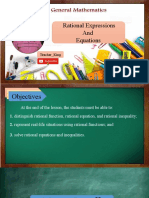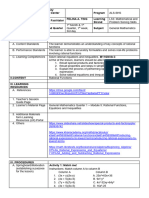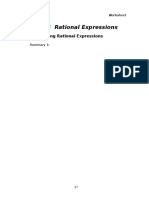Math 0362 Unit 2 Chapter 7 - Rationals: Updated: Summer 2015
Uploaded by
Afsana MohammadMath 0362 Unit 2 Chapter 7 - Rationals: Updated: Summer 2015
Uploaded by
Afsana MohammadMath 0362
Unit 2
Chapter 7 - Rationals
Updated: summer 2015
7.1 Rational Functions and Expressions
Objectives:
Find the domain of a rational expression using zero factor theorem
Simplify rational expressions
Write equivalent forms of rational expressions
Rational Expression:
The domain of a function is the set of all real numbers except those values that make the
denominator zero. The answer is written in the form:
5x2 3
f ( x)
x 1
x x is a real number and x 0
f ( x)
x 1
(,1) (1, )
Interval Notation
7x 2
7x 2
x 7 x 6 ( x 6)( x 1)
2
x 6, 1
(, 6) (6, 1) (1, )
Interval Notation
Domain:
Domain:
Find the domain of a rational expression, write in INTERVAL NOTATION:
1) f ( x)
8 x3 7 x 2 20
2
2) g ( x)
5x2 3
x 1
3)
f ( x)
7x 2
x 2 2 x 15
Simplifying Rational Expressions:
Step one:
Completely factor the numerator and denominator of the rational expression
Step two:
Divide out factors common to the numerator and denominator.
2 x2
4)
10 x3 2 x 2
9 x 2 13x 4
5)
8x2 x 7
2 y2 2 y
7*) 3
y 5 y2 y 5
36 x 2
8*)
x6
0362 Unit 2 Ch 7
Professor K McCollum
18 2 x 2
6*) 2
x 2x 3
pg. 2
7.2 Multiply & Divide Rational Expressions
Objectives: Multiply and Divide rational expressions
Multiplying Rational Expression:
Step 1:
Step 2:
Step 3:
Step 4:
Completely factor the numerator and denominator
Write as a multiplication problem
Simplify by dividing out common factors
Keep answer in factored form
7 x 2 3 y 5
*
5 y 14 x 2
3*
3x 3 2 x 2 x 3
*
5x 5x2
4x2 9
x2 x
6
*
3x
5x 5
Dividing Rational Expressions:
Multiply by the RECIPROCAL -
x4 x4 x4
3
*
=
5
3
5
x4
Follow the rules for multiplication of rational expressions
6 x 2 3x 2 x
x2 1
x 1
x 3 5 x 15
x 2 9 x 3 2
0362 Unit 2 Ch 7
Professor K McCollum
2 x 2 11x 5 4 x 2
5 x 25
10
pg. 3
7.3 Adding & Subtracting Rational Expressions
Objectives:
Add and Subtract Rational Expressions with a common denominator
Find the Least Common Denominator (LCD) of a list of rational expressions
Write equivalent expressions
Adding or Subtracting Rational Expressions with Common Denominators:
Add or subtract the numerators and place the sum or difference over the common denominator
9
3
93
12
x2 x2 x2 x2
3x 10 x 2 3 x 10 x 2 3x 10 x 2 7 x 2
7x 2
or x 1
x 1
x 1
x 1
x 1
x 1
1)
2y
7
2y 7 2y 7
2*)
3x 2 2 x 10 x 5
x 1
x 1
3)
4p 3 3p 8
2p 7 2p 7
4)
2 x 1 3x 6
x3
x3
0362 Unit 2 Ch 7
Professor K McCollum
pg. 4
Finding the Least Common Denominator:
Step 1:
Factor each denominator completely
Step 2:
The LCD is the product of all unique factors found in step 1, each raised to a power equal to
the greatest number of times that the factor appears in any one factored denominator
4 11
,
9 y 15 y 3
LCD: _______________________________
7
5x2
,
x2 x2
LCD: _______________________________
t 10
t 5
,
t 2 t 6 t 2 3t 2
LCD: _______________________________
Rewrite each rational expression as an equivalent expression
8)
9 y 45 y 3
9)
x 2 ( x 2)( x 2)
10)
5x2
x 2 ( x 2)( x 2)
11)
t 10
(t 3)(t 2) (t 3)(t 2)(t 1)
12)
t 5
(t 2)(t 1) (t 3)(t 2)(t 1)
0362 Unit 2 Ch 7
Professor K McCollum
pg. 5
7.4 Adding & Subtracting Rational Expressions with Unlike Denominators
Objectives:
Find the Least Common Denominator (LCD) of a list of rational expressions & write equivalent expressions
Add and Subtract Rational Expressions with unlike denominators
Adding & Subtracting Rational Expressions with Unlike Denominators
Step 1 Find the LCD of the rational expressions
Step 2 Rewrite each rational expression as an equivalent expression from step 1
Step 3 Add or Subtract the numerators, write this over the LCD
Step 4 Simplify
a 2a
4 8
5*
2x
x
2
x 2x 1 x 1
3
7
2
10 x 25 x
6*
5
6
x2
12 x
6
x 25 x 5
x 2 x 6
x
4x
3
2x
2x x 6x 3
8*
x4
x 1
2
x 12 x 20 x 8 x 20
0362 Unit 2 Ch 7
Professor K McCollum
pg. 6
7.5 Solving Equations with Rational Expressions
Objectives:
Solve equations containing rational expressions
Solve equations with rational expressions for a specified variable
Solving Equations Containing Rational Expressions:
Step 1
Step 2
Step 3
Eliminate the Denominator: Multiply both sides of the equation by the LCD of all
rational expressions in the equation
Solve the resulting equation
Check the solution in the original equation (hint: look at the domain)
1)
x 8 1
2 3 6
2)
3)
4x
2
1
x 2 x 30 x 5 x 6
4*)
2x
8
1
x4 x4
x
5*)
6
x8
x
14
7x
1
x2 x2
6*)
y
2 y 16 2 y 3
2y 2 4y 4
y 1
7)
x 1 x 2 11x x 3
x 3 x2 x 6 x 2
0362 Unit 2 Ch 7
Professor K McCollum
pg. 7
7.6 Proportion and Problem Solving with Rational Equations
Objective:
Solve Proportions using cross products
Use Proportions to solve problems
Cross Multiply to solve proportions
45 5
1
x 7
The quotient of a number and 6, minus
x 5 x 2
3
5
5
is the quotient of the number and 2. Find the number.
3
Finding Work Rates: (Set up a chart!)
4
Sam can complete a job in 3 hours. Frank needs 7 hours to complete the same job. How long will it
take for Sam and Frank to complete the same job working together?
5
Sue can paint the house in 4 days. Jon can paint the same house in 6 days. How long would it take
for them to paint the house together?
Problems with Distance: Remember that Distance = Rate * Time (Set up a chart!)
Strategy:
Make a chart for your information and formula
Set up as a proportion
Cross Multiply & Solve
6
A jogger begins her workout by jogging to the park, a distance of 7 miles. She then jogs home at the
same speed, but along a different route. This return trip is 12 miles, and her time is one hour longer. Find
her jogging speed.
7
A cyclist rode the first 33 mile portion of his workout at a constant speed. For the 21 mile cool down
portion of his workout, he reduced his speed by 4 miles per hour. Each portion of the workout took the
same time. Find the cyclists speed during the first portion and find his speed during the cool down.
0362 Unit 2 Ch 7
Professor K McCollum
pg. 8
7.7 Simplifying Complex Fractions
Objectives:
Simplify complex fractions by simplifying the numerator and denominator and then divide
Simplify complex fractions by using LCD
S
Step 1
Step 2
Step 3
Method 1
Step 1
Step 2
x
27 y 2
6 x2
9
Method 2
Step 1
Step 2
5
x2
10
x2
Simplify the numerator and denominator into single rational expressions
Invert / Multiply / Simplify
x 1
y2 y
y 1
x2 x
Write as a single fraction divided by single fraction
Invert the second fraction and multiply
Simplify
1
x
1
4x
x
2
Multiply the numerator & denominator of the complex fraction by the LCD of
all fractions in both the numerator & denominator
Simplify
4
5
5 x x 5
2
3
x x 5
0362 Unit 2 Ch 7
2
4
x5 x3
3x 13
2
x 8 x 15
Professor K McCollum
pg. 9
You might also like
- 6 Rational Expressions and Operations On Rational ExpressionsNo ratings yet6 Rational Expressions and Operations On Rational Expressions15 pages
- Simplifying Rational Expressions SSP February 15 2022No ratings yetSimplifying Rational Expressions SSP February 15 202223 pages
- Rational Expressions Simplifying: Section 11.3No ratings yetRational Expressions Simplifying: Section 11.330 pages
- PERFORMING-OPERATIONS-ON-RATIONAL-ALGEBRAIC-EXPRESSIONSNo ratings yetPERFORMING-OPERATIONS-ON-RATIONAL-ALGEBRAIC-EXPRESSIONS14 pages
- Rational Expressions: in Exercises 28-34, Factor Completely, or State That The Polynomial Is PrimeNo ratings yetRational Expressions: in Exercises 28-34, Factor Completely, or State That The Polynomial Is Prime15 pages
- Learning Module in Math 8: Date Most Essential Learning CompetenciesNo ratings yetLearning Module in Math 8: Date Most Essential Learning Competencies15 pages
- Mathematics 8 Quarter 1 Week 4: NAME: - GR & SEC: - CompetenciesNo ratings yetMathematics 8 Quarter 1 Week 4: NAME: - GR & SEC: - Competencies10 pages
- Intermediate Algebra Unit 6 Rational ExpressionsNo ratings yetIntermediate Algebra Unit 6 Rational Expressions46 pages
- Module Six Lesson Two Notes Guided NotesNo ratings yetModule Six Lesson Two Notes Guided Notes11 pages
- Emanuel Perez-Tovilla - Lesson 4 - Must Be a Rational ExplanationNo ratings yetEmanuel Perez-Tovilla - Lesson 4 - Must Be a Rational Explanation18 pages
- Rational Expression: (Realgrace C. Monserata, TMA, Grade 8-Math 2 Quarter)No ratings yetRational Expression: (Realgrace C. Monserata, TMA, Grade 8-Math 2 Quarter)10 pages
- Gen Math Notes GeGeneral Mathematics Book 2No ratings yetGen Math Notes GeGeneral Mathematics Book 216 pages
- Mathematics: Learner's Activity Sheet Assessment ChecklistNo ratings yetMathematics: Learner's Activity Sheet Assessment Checklist13 pages
- 6 Rational Expressions and Operations On Rational Expressions6 Rational Expressions and Operations On Rational Expressions
- Simplifying Rational Expressions SSP February 15 2022Simplifying Rational Expressions SSP February 15 2022
- PERFORMING-OPERATIONS-ON-RATIONAL-ALGEBRAIC-EXPRESSIONSPERFORMING-OPERATIONS-ON-RATIONAL-ALGEBRAIC-EXPRESSIONS
- Rational Expressions: in Exercises 28-34, Factor Completely, or State That The Polynomial Is PrimeRational Expressions: in Exercises 28-34, Factor Completely, or State That The Polynomial Is Prime
- Learning Module in Math 8: Date Most Essential Learning CompetenciesLearning Module in Math 8: Date Most Essential Learning Competencies
- Mathematics 8 Quarter 1 Week 4: NAME: - GR & SEC: - CompetenciesMathematics 8 Quarter 1 Week 4: NAME: - GR & SEC: - Competencies
- Emanuel Perez-Tovilla - Lesson 4 - Must Be a Rational ExplanationEmanuel Perez-Tovilla - Lesson 4 - Must Be a Rational Explanation
- Rational Expression: (Realgrace C. Monserata, TMA, Grade 8-Math 2 Quarter)Rational Expression: (Realgrace C. Monserata, TMA, Grade 8-Math 2 Quarter)
- Mathematics: Learner's Activity Sheet Assessment ChecklistMathematics: Learner's Activity Sheet Assessment Checklist



























































